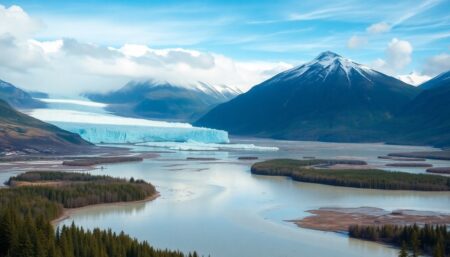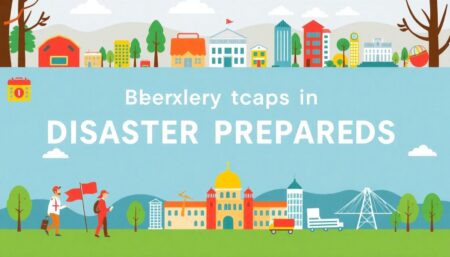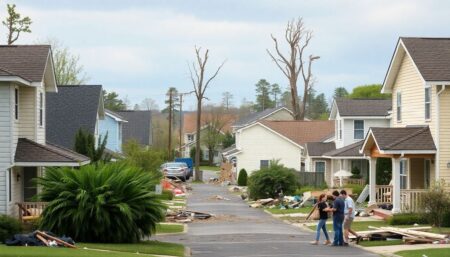Welcome to our in-depth exploration of the Indian Ocean tsunami, a catastrophic event that shook the world 20 years ago. This article aims to provide a comprehensive look at the disaster, its impact, and the lessons learned. Join us as we delve into the human stories, the global response, and the scientific insights gained from this tragic event.
Reflecting on the devastation, the global response, and the lessons learned
Imagine a wall of water, towering up to 30 meters high, marching towards the coastlines of countries rimming the Indian Ocean. In a matter of hours on a seemingly tranquil December morning in 2004, the third-largest earthquake ever recorded triggered a tsunami of unimaginable scale. The waves swallowed entire communities, flattened buildings, and swept people and debris inland, leaving a trail of devastation that stretched from Indonesia to Africa.
The sheer power of the tsunami defied comprehension. Coastal towns were reduced to mere matchsticks, and lush landscapes were transformed into desolate wastelands. The human toll was catastrophic, with over 230,000 lives lost and countless more displaced. The eerie silence that followed the roaring waves was punctuated only by the cries of survivors and the distant hum of emergency vehicles.
In response to the unfathomable disaster, the global community rallied in an unprecedented show of solidarity. Aid poured in from every corner of the globe, with governments, NGOs, and individuals contributing to a massive relief effort. Military forces from various nations joined hands to provide immediate assistance, while humanitarian organizations worked tirelessly to rebuild shattered lives and communities. The outpouring of support served as a poignant reminder of our shared humanity in the face of such profound tragedy.

The Day the Waves Came
In the early hours of December 26, 2004, the world awoke to one of the most devastating natural disasters in recorded history. At 7:58 AM local time, a colossal earthquake, measuring between 9.1 and 9.3 on the Richter scale, struck off the western coast of Northern Sumatra, Indonesia. The quake, caused by the sudden release of centuries of built-up tectonic strain, was so powerful that it caused the entire planet to vibrate by as much as 1 centimeter and altered the Earth’s rotation slightly. The epicenter was located at a depth of 30 kilometers under the Indian Ocean, triggering a series of catastrophic tsunamis that would leave an indelible mark on the region and the world.
The tsunamis, generated by the massive displacement of water, radiated outward from the epicenter like ripples in a pond, but with far deadlier consequences. The waves, reaching heights of up to 30 meters, swept through the coasts of 14 countries, including Indonesia, Sri Lanka, India, and Thailand. The tsunami’s path was unpredictable and swift, with waves traveling at speeds of up to 800 kilometers per hour, catching communities completely off guard. By the end of the day, the tsunamis had inundated coastal areas with devastating force, causing untold destruction and turning once-idyllic shorelines into scenes of unimaginable chaos.
The immediate impact of the earthquake and tsunamis was nothing short of apocalyptic. Entire villages were washed away, and thousands of people were swept out to sea. In Indonesia’s Aceh province, the hardest-hit region, the city of Banda Aceh was virtually erased from the map. Personal stories of survival and loss began to emerge amidst the wreckage. Tilly Smith, a 10-year-old British girl on vacation in Thailand, recognized the signs of an impending tsunami from a school lesson and warned her family, saving them and dozens of others. Meanwhile, thousands of families were torn apart, left to search for loved ones amidst the debris and destruction.
The sheer magnitude of the devastation was difficult to comprehend. Some of the most iconic images from the event—such as the washed-up boats inland and the sheer destruction of coastal communities—only began to scratch the surface of the true horror. The initial shock left governments and aid agencies scrambling to respond. Communication networks were severely disrupted, making it difficult to assess the full extent of the damage and coordinate relief efforts. In the days that followed, the world would come to grips with the staggering loss of life and the monumental task of rebuilding and healing that lay ahead. The final death toll was estimated to be around 230,000 people, making it one of the deadliest natural disasters in history. The event served as a stark reminder of nature’s raw power and the importance of preparedness and international cooperation in the face of such calamities.

The Aftermath: Loss and Resilience
In the grim aftermath of the tsunami, the world watched in horror as the true extent of the disaster began to unfold. The loss of life was catastrophic, with communities along the coastline particularly devastated. The numbers were staggering: thousands of lives were claimed by the waves, leaving families torn apart and communities shattered. The sheer force of the water flattened entire villages, sweeping away homes, businesses, and beloved landmarks. What was once a thriving coastal landscape was reduced to a scene of unimaginable destruction, with debris and remnants of lives scattered across the muddy, ravaged terrain.
The destruction of communities was not merely physical; it was emotional and psychological as well. Survivors grappled with the trauma of witnessing the sheer power of nature’s fury and the heart-wrenching loss of loved ones. Children were left without parents, parents without children, and entire families were wiped out. The social fabric that had bound these communities together was frayed, leaving survivors to grapple with a new, harsh reality. Yet, amidst the despair, there were glimmers of hope and resilience.
The resilience shown by survivors was a testament to the indomitable human spirit. In the face of unimaginable loss, people came together to support one another. Stories emerged of heroes who risked their lives to save others, of neighbors who opened their homes to those left homeless, and of communities that rallied to provide food, water, and shelter to those in need. This collective strength became a beacon of hope in the darkest of times, a reminder that even in the midst of tragedy, humanity could shine through.
- There was the story of Aisha, a mother of three, who lost her home and her small business but found the strength to start a communal kitchen to feed her neighbors.
- Mr. Tanaka, an elderly fisherman, saw his lifelong livelihood destroyed, but he began organizing cleanup efforts, rallying the younger generation to rebuild their village.
- The local schoolteacher, Maria, turned her school into a temporary shelter, ensuring that children had a safe space to play and learn while their parents worked to rebuild.
These stories, and countless others like them, served as a powerful reminder that even in the face of overwhelming loss, the human spirit could rise, phoenix-like, from the ashes.

The Global Response: Aid and Politics
The international response to the tsunami was swift and comprehensive, as governments and individuals alike rallied to provide aid to the affected regions. The sheer scale of the disaster, which left hundreds of thousands of people displaced and in need of urgent assistance, prompted an outpouring of support from around the world. Governments pledged millions of dollars in aid, while individual donors contributed generously to relief efforts. The United Nations, along with other international organizations, played a pivotal role in coordinating the global response, ensuring that aid was delivered efficiently and effectively to those in need. The international community demonstrated a remarkable sense of solidarity and compassion, transcending borders and cultural differences to provide support during this critical time.
The political maneuvering and strategic interests of major powers became evident in their relief efforts. Here’s a breakdown of how key players responded:
- The United States, as one of the largest donors, provided significant military and logistical support, deploying aircraft carriers and naval vessels to assist in search and rescue operations. This served a dual purpose: it demonstrated the U.S.’s capacity for humanitarian assistance and reinforced its strategic presence in the region.
- The European Union and its member states collectively contributed substantial aid, emphasizing their commitment to global humanitarian efforts. This also served to strengthen their political and economic ties with the affected countries.
- China, emerging as a major global player, saw the tsunami relief as an opportunity to enhance its international image and expand its influence. The country provided significant aid and sent a medical team to assist in relief efforts, marking a shift in its role in global humanitarian actions.
- India, being closer to the affected regions, took a leading role in the relief efforts. The country’s prompt response, including the deployment of its navy and air force, underscored its strategic interests and reinforced its position as a regional power.
In addition to governmental aid, the tsunami response highlighted the power of individual and collective action. Non-governmental organizations (NGOs) and civil society groups mobilized quickly to provide on-the-ground support, often filling gaps left by governmental agencies. Individual donors, through online platforms and fundraising events, contributed significantly to the relief efforts. This collective effort underscored the importance of grassroots initiatives in responding to large-scale disasters and highlighted the potential for global solidarity in times of crisis.
However, the international response to the tsunami also revealed the complexities and challenges of global humanitarian efforts. Coordination among various stakeholders—including governments, NGOs, and international organizations—was not always seamless, leading to delays and inefficiencies in the delivery of aid. Political tensions and strategic interests sometimes overshadowed the humanitarian imperative, raising questions about the motivations behind certain aid contributions. Despite these challenges, the tsunami relief effort served as a valuable lesson in the importance of international cooperation and the need for more effective coordination mechanisms in future disaster responses.

Lessons Learned: Preparedness and Warning Systems
The devastating tsunami of 2004 in the Indian Ocean left the world with invaluable lessons about the importance of effective warning systems and preparedness. The colossal waves that struck multiple countries claimed hundreds of thousands of lives and caused unprecedented destruction, highlighting the stark reality that existing systems were woefully inadequate. The absence of a robust early warning mechanism and the lack of public awareness about tsunami risks were among the most glaring shortcomings. The disaster underscored the urgent need for investment in advanced detection technologies and comprehensive education initiatives to ensure communities are better prepared for future events.
In response to the 2004 tragedy, significant strides have been made to enhance tsunami warning systems in the Indian Ocean. The Indian Ocean Tsunami Warning and Mitigation System (IOTWMS) was established, integrating a network of seismic stations, buoys, and tide gauges to monitor seismic activity and sea-level changes. This regional cooperation has led to the development of national warning centers and standardized communication protocols, aiming to facilitate swift and accurate information dissemination. Furthermore, public awareness campaigns and evacuation drills have become more common, empowering coastal communities to respond appropriately to tsunami threats.
Despite these advancements, ongoing risks persist, and several challenges remain. Key concerns include:
- Ensuring the long-term sustainability and maintenance of warning systems, which can be hampered by financial constraints and technological limitations.
- Addressing gaps in communication infrastructure, particularly in remote and vulnerable coastal areas.
- Enhancing regional cooperation and data sharing among countries to improve the accuracy and speed of tsunami detection and warning.
Looking ahead, it is crucial to build on the progress made thus far and address the outstanding issues. Continued investment in research and technology can drive innovation in tsunami detection and forecasting. Prioritizing community engagement and education can foster a culture of preparedness and resilience. Moreover, strengthening international collaborations can help create a unified front against the ever-present threat of tsunamis, ultimately saving lives and protecting communities across the Indian Ocean region.
FAQ
What caused the Indian Ocean tsunami?
Which countries were most affected by the tsunami?
- Indonesia, with over 165,000 deaths
- Sri Lanka, with 35,262 deaths
- India, with 16,389 deaths
- Thailand, with 8,240 deaths
- The Maldives, with 108 deaths
Other countries also reported fatalities and significant damage.









